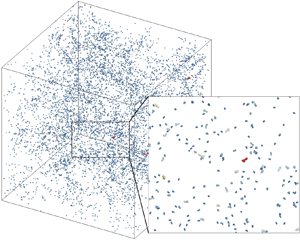Crossref Citations
This article has been cited by the following publications. This list is generated based on data provided by
Crossref.
Pu, Hang
Dong, Ming
Shang, Yan
Zhang, Zeping
and
Wang, Shuang
2021.
Numerical Investigation of Micro-Particle Agglomeration Phenomenon Under the Influence of Cylindrical Vortex Wake.
SSRN Electronic Journal ,
Ruan, Xuan
Gorman, Matthew T.
Li, Shuiqing
and
Ni, Rui
2022.
Surface-resolved dynamic simulation of charged non-spherical particles.
Journal of Computational Physics,
Vol. 466,
Issue. ,
p.
111381.
Fang, Zhu
Zhang, Yiyang
Wu, Xinxin
Sun, Libin
and
Li, Shuiqing
2022.
New explicit correlations for the critical sticking velocity and restitution coefficient of small adhesive particles: A finite element study and validation.
Journal of Aerosol Science,
Vol. 160,
Issue. ,
p.
105918.
Qian, Xiaoyu
Ruan, Xuan
and
Li, Shuiqing
2022.
Effect of interparticle dipolar interaction on pore clogging during microfiltration.
Physical Review E,
Vol. 105,
Issue. 1,
Ruan, Xuan
and
Li, Shuiqing
2022.
Effect of electrostatic interaction on impact breakage of agglomerates formed by charged dielectric particles.
Physical Review E,
Vol. 106,
Issue. 3,
Chen, Sheng
Chen, Pinzhuo
and
Fu, Jianhong
2022.
Drag and lift forces acting on linear and irregular agglomerates formed by spherical particles.
Physics of Fluids,
Vol. 34,
Issue. 2,
Zhao, Yanlin
Liu, Min
Wang, Chi-Hwa
Matsusaka, Shuji
and
Yao, Jun
2023.
Electrostatics of granules and granular flows: A review.
Advanced Powder Technology,
Vol. 34,
Issue. 1,
p.
103895.
Chen, Bingqi
Liu, Daoyin
Chen, Zhao
and
Liu, Malin
2023.
Langevin dynamics simulation and collision frequency modification in population balance model of nanoparticle coagulation during simultaneous agglomeration and sintering.
Journal of Aerosol Science,
Vol. 174,
Issue. ,
p.
106259.
Fang, Zhu
Qian, Xiaoyu
Zhang, Yiyang
Liu, Wenwei
and
Li, Shuiqing
2024.
A new discrete element method for small adhesive non-spherical particles.
Journal of Computational Physics,
Vol. 513,
Issue. ,
p.
113193.
Ruan, Xuan
Gorman, Matthew T.
and
Ni, Rui
2024.
Effects of electrostatic interaction on clustering and collision of bidispersed inertial particles in homogeneous and isotropic turbulence.
Journal of Fluid Mechanics,
Vol. 980,
Issue. ,
Geng, Pengfei
Chen, Xiaoping
Ma, Jiliang
Liang, Cai
and
Yang, Wenming
2024.
Energy dissipation and sticking/rebound behaviors of nanoparticle aggregates to the wall at oblique impact.
Advanced Powder Technology,
Vol. 35,
Issue. 7,
p.
104466.
Wang, Yating
Zhang, Yiyang
Fang, Zhu
and
Wu, Xinxin
2024.
The effect of surface roughness on the viscoelastic energy dissipation in a particle–wall collision.
Journal of Aerosol Science,
Vol. 175,
Issue. ,
p.
106280.
Fu, Jingwen
Liu, Wenwei
Jin, Xing
and
Huang, Yun
2024.
Numerical investigation on particle inertial migration in circular Poiseuille flow with thermal convection.
Physical Review Fluids,
Vol. 9,
Issue. 6,
Motamedi, Ehsan
Moosaie, Amin
and
Rahmani, Behrooz
2025.
Direct numerical simulation of pollutant adsorption by charged inertial spheroidal particles suspended in a homogeneous isotropic turbulent flow.
Physics of Fluids,
Vol. 37,
Issue. 4,
Ruan, Xuan
Diaz-Lopez, Miguel X.
Gorman, Matthew T.
and
Ni, Rui
2025.
Direct numerical simulations on transport and deposition of charged inertial particles in turbulent channel flow.
Journal of Fluid Mechanics,
Vol. 1010,
Issue. ,
Wu, Shun-Jie
Cai, Rong-Rong
and
Zhang, Li-Zhi
2025.
Nanoparticle dynamics and aggregation behavior in nanofluids: A particle-scale simulation study.
Physical Review E,
Vol. 112,
Issue. 1,
Chi, Jialiang
Wang, Jinjun
Su, Meixuan
Zhao, Yao
and
Wang, Zhiqiang
2025.
Analysis of the charging characteristics of MgO powder in the feeding tube of a mineral insulated cable filling device.
Journal of Electrostatics,
Vol. 134,
Issue. ,
p.
104039.
Chen, Pinzhuo
Chen, Sheng
Fu, Jianhong
and
Liu, Mingyu
2025.
Impact of wall-normal external force on particle collision dynamics in turbulent channel flow.
International Journal of Multiphase Flow,
Vol. 192,
Issue. ,
p.
105344.

 $A{d_n}$, revealing the major role of interparticle adhesion in the collision process. When the effects of Coulomb repulsion and adhesion both exist, particles with moderate collision velocities are more likely to contribute to the formation of agglomerates. The structure of the agglomerates is then measured using the fractal dimension. It is found that, due to its isotropic feature, Coulomb repulsion effectively reduces the agglomeration rate but has a negligible effect on the structure of agglomerates.
$A{d_n}$, revealing the major role of interparticle adhesion in the collision process. When the effects of Coulomb repulsion and adhesion both exist, particles with moderate collision velocities are more likely to contribute to the formation of agglomerates. The structure of the agglomerates is then measured using the fractal dimension. It is found that, due to its isotropic feature, Coulomb repulsion effectively reduces the agglomeration rate but has a negligible effect on the structure of agglomerates.

